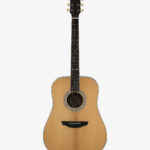Tuning your acoustic guitar is crucial for achieving the rich, resonant sound it’s known for. Whether you’re a beginner just learning chords or a seasoned player practicing scales, an in-tune guitar is essential. Luckily, you’ve landed in the perfect spot to easily tune your instrument. Our Acoustic Guitar Tuner Online provides a fast, accurate, and free way to get your guitar sounding its best, right through your device’s microphone. This tuner works seamlessly for both acoustic and electric guitars, making it your go-to tool for perfect pitch.
Standard Acoustic Guitar Tuning: Notes for Each String
Before you start tuning, it’s helpful to know the standard notes for each string on your acoustic guitar. Starting from the thinnest string (closest to the floor when you play) to the thickest, the standard tuning is:
- 1st String (thinnest) – E4
- 2nd String – B3
- 3rd String – G3
- 4th String – D3
- 5th String – A2
- 6th String (thickest) – E2
This standard tuning is the most common and versatile for acoustic guitar playing, used across countless genres and songs.
How to Use the Online Acoustic Guitar Tuner for Acoustic Guitars
Using our acoustic guitar tuner online is straightforward and user-friendly. Here’s a step-by-step guide to get your acoustic guitar in tune quickly:
- Enable the Tuner: Click the “Turn on” button located just below the tuner display. This will activate the tuner and prepare it to listen to your guitar.
- Microphone Access: Your device will prompt you to grant permission for microphone access. It’s essential to allow this so the online acoustic guitar tuner can hear the sound of your guitar strings. Click “Allow” or “Grant Permission” when prompted.
- Play a String: Pluck any string on your acoustic guitar clearly and let it ring.
- Read the Tuner: The chromatic tuner will instantly detect the note you are playing and display it. It will also show you how close you are to being perfectly in tune.
- Adjust Tuning Pegs: Observe the tuner display. If the note is sharp (too high) or flat (too low), gently turn the corresponding tuning peg on your guitar’s headstock. Turning the peg will either tighten or loosen the string, changing its pitch.
- Tune to Green: Continue adjusting the tuning peg until the note displayed on the tuner turns green. Green indicates that the string is perfectly in tune with the target note. Congratulations, that string is now correctly tuned!
- Tune All Strings: Repeat steps 3-6 for each of the six strings, following the standard tuning order (or any order you prefer).
- Fine-Tuning and Re-Checking: After tuning all six strings, it’s a good practice to go back and check each string again. Adjusting one string can sometimes slightly affect the tuning of others due to changes in neck tension. A quick re-check ensures optimal tuning across all strings.
By following these simple steps, you’ll have your acoustic guitar perfectly tuned using our acoustic guitar tuner online in no time.
Achieving the Best Tuning Quality for Your Acoustic Guitar
While our online acoustic guitar tuner is highly accurate, a few factors can influence the tuning quality. The accuracy largely depends on your device’s microphone and the presence of background noise.
- Minimize Background Noise: Tune your acoustic guitar in a quiet environment. Loud окружающий noises can interfere with the microphone’s ability to accurately pick up the guitar string’s frequencies.
- Microphone Quality: While most device microphones are sufficient, higher quality microphones will generally provide more accurate results. However, our tuner is designed to work effectively even with standard microphones.
- Consider Ear Training: For situations with microphone issues or as a supplementary skill, developing your ear to recognize correct pitches is beneficial. While our acoustic guitar tuner online offers visual precision, ear training enhances your overall musicality. For practice, we also provide sounds of the strings on this page to help you tune by ear.
How Often Should You Tune Your Acoustic Guitar?
Regular tuning is a part of acoustic guitar maintenance. Several factors necessitate periodic tuning:
- Playing Frequency: Active playing naturally causes strings to go slightly out of tune. As a general guideline, tuning your acoustic guitar every time you play, or at least before each practice session, is recommended for critical listening or recording.
- Environmental Changes: Fluctuations in temperature and humidity significantly impact the wood of your acoustic guitar and the strings. Changes can cause expansion or contraction, affecting tuning stability. Tune your guitar more frequently during seasonal changes or when moving between different environments.
- Storage: Even when not played, an acoustic guitar can lose tuning over time due to string tension relaxing or environmental factors. If your guitar hasn’t been tuned in over a week, it likely needs adjustment.
- New Strings: When you put on new strings, they will stretch and settle in, requiring more frequent tuning initially. Expect to tune new strings several times in the first few days until they stabilize.
To maintain your acoustic guitar’s optimal sound, make tuning a regular habit. For most players, tuning every 1-2 hours of playtime is a good practice.
Make “guitarplayers.net” your bookmark for all your tuning needs! With our acoustic guitar tuner online, keeping your acoustic guitar perfectly in tune will always be quick and easy. Enjoy playing!


